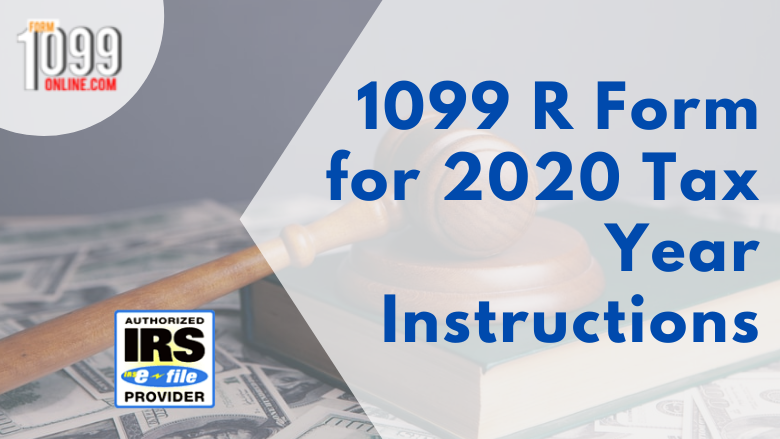Filing 1099 R Form Online: Have you received a distribution from an IRA in the previous year? You’ll receive a 1099 R From. File 1099 R Form to report distributions you may receive from your retirement plans, IRA, annuity, pension, etc.
Table of Contents
- What is the purpose of filing the 1099 R Form?
- What does your 1099 R show?
- Why did you receive Form 1099 R?
- How to report 1099 R Form on 1040 Form
- 1099 R form new types of distributions for 2024
- When is IRS 1099 R not required?
Are you confused about the 1099 R Tax Form? we’ll let you know about filing the 1099 R Form for the 2024 tax year. We provide you with detailed information for 2024.

What is the purpose of filing the 1099 R Form?
File Form 1099 R for distributions for pensions, annuities, retirement or profit-sharing plans, insurance contracts, etc. Also, report the payments for each person to whom you have made a designated distribution of $10 or more. Besides, Use Form 1099 R to report the distributions made from any IRAs, survivor income benefit plans, permanent and total disability payments under LICs, etc.
Therefore, the main purpose of filing the 1099 R Form is to report death benefit payments made by employers that are not made as a part of a pension.
What does your 1099 R show?
You can find the below information on the 1099 R tax form:
- The total amount of your monthly gross benefit.
- The total amount of federal and state tax withheld during the year.
- Also, the amount of your benefit is not taxable.
- Amount of health insurance premiums you paid last year. If you’re eligible for a health insurance credit, the amount shown on your 1099 Forms is the difference between the total health insurance premium amount and the health credit amount.
Note: If you receive a health insurance credit, the amount is not on your 1099 R Form. The health insurance credit is a non-taxable benefit. 1099 R Forms don’t include non-taxable benefits with taxable income.
Why did you receive Form 1099 R?
If you received a distribution from your retirement plan amounting to $10 or more, you can expect to receive a copy of Form 1099 R. The Form must be used to help the IRS determine how much taxable income you had the previous year. But remember one thing, both taxable and taxable distributions will be listed on the Form. Whether or not you’ll pay taxes on the distributions you receive will depend on the type of distribution. For example:
Hardship distribution–
Termination or hardship distributions report on Form 1099 R. The taxable amount is reported in box 2a. You’ll receive two 1099 R if you have a distribution that includes Roth and non-Roth money.
Deemed distributions–
If you borrow money from your qualified retirement plan and the loan goes into default because you stopped making payments. If so, then you’ll receive a 1099 R Form showing the taxable amount.
Loans offset upon the termination of employment
If you terminate employment with a current loan, the outstanding loan balance included as part of your termination distribution becomes taxable. You’ll receive a 1099 R showing the taxable amount.
How to report the 1099 R Form on the 1040 Form?
If you received a Form 1099 R from any trust, that means you received a distribution of $10 or more from your retirement plan. Or else you may have an outstanding loan balance from your plan that became a taxable distribution.
The IRS requires the organizations or any trusts to send a Form 1099 R by February 1st, 2024. Otherwise, it may take up to 10 days for the Form to arrive with mailing time.
When you receive your Form 1099 R, it’s important to remember that distributions from traditional 401(k) accounts are generally reported on income taxes. Also, you need to contact a financial advisor to determine the exact taxable amount. Check whether you need to file a Form with your tax return.
1099 R form new types of distributions for 2024
The two new types of distributions were introduced for the 2024 tax year.
- The first, as part of the Secured Act, was the Qualified Birth and Adoption Distribution. The distribution waives a 10% early withdrawal penalty and is allowed to be re-contributed.
- Also, the second distribution type introduced by Cares Act was the Coronavirus-related distribution. This type of distribution can have taxation equally spread over three years. It waives a 10% early withdrawal penalty and allows you to contribute.
When is the IRS 1099-R not required?
Generally, every 1099 Form does need to be filed in some circumstances. The cases below where IRS 1099 R is not required:
- Don’t report payments subject to withholding of Social Security and Medicare taxes on this Form. Report such payments on Form W-2, Wage, and tax statements.
- Amounts exempt from tax, such as worker’s compensation report on Form 1099 R. However if part of the distribution is taxable and another part is non-taxable. Report the entire distribution in box 1 and the taxable part in box 2a.
- Also, no special reporting for qualified charitable distributions, or qualified health savings account funding distributions.
Are you thinking of filing your IRS 1099-R form? How would you file? Choose the online filing process for accurate speed and to save time. Also, we provide you service to file your 1099 Forms electronically. Form1099online is one of the best IRS-authorized e-file providers.
